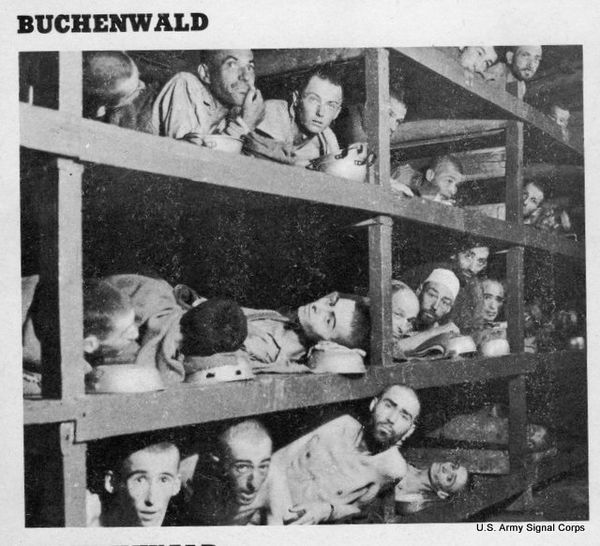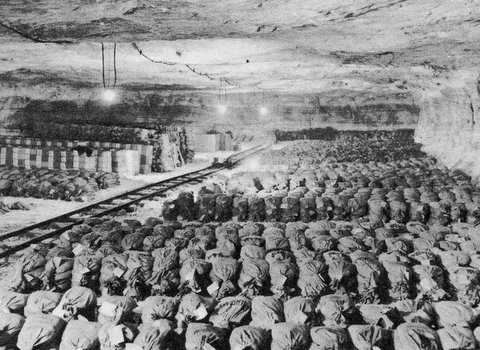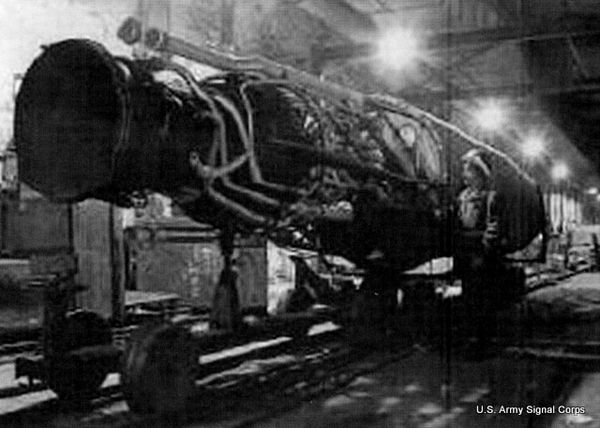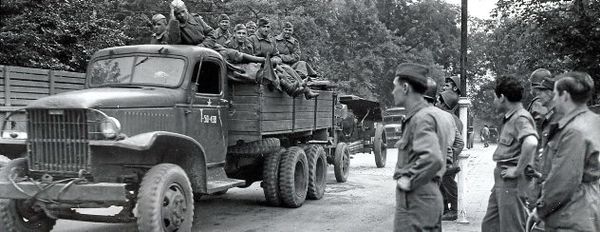How the U.S. Army burglarized the Russian Zone - Occupied Germany 1945
Jul 27, 2016 18:44:44 #
During the Yalta Conference in February, 1945, America, Britain and Russia defined the borders of their future Occupation Zones in Germany. Whoever overran the borders during combat agreed to eventually withdraw.
On March 31, 1945, three American armies, including generals Patton and Bradley, had crossed Germany and paused before the eastern German states of Thuringia and Saxony -- the Russian Occupation Zone.
But the Russians were not there -- and the Nazis were. A major concentration camp, Buchenwald, waited to be rescued, so the order to attack was given.
After routing the Nazis and freeing some 22,000 prisoners, the Americans set up 34 provisional Military Government offices throughout the 16,400 square-mile region. The Russians were busy attacking Berlin, their prime military goal.
But we had different goals in mind.
Among our combat troops were T Force personnel, eager to raid such high-tech companies as Carl Zeiss Jena, Schott Optics and Glass, Siemens and Halske, Telefunken, Junkers Aircraft, Agfa. BMW, Krupp, I. G. Farben, and others: a total of more than 50 firms. The target list came from CIOS (Combined Intelligence Objectives Subcommittee).
T Force's orders were to expropriate any and all scientific and engineering machinery, patents, blueprints, formulae, models, prototypes, and "intellectual property" for the Office of the Alien Property Custodian in Washington (and major U.S. corporations who sent representatives to help in the selections).
However, this meant the Americans were in violation of the Yalta Conference. They were deliberately burglarizing properties belonging to the Russian Occupation Zone. Naturally, T Force was only following orders, a familiar argument in war on both sides.
Then a hidden agenda began to slowly emerge. The original intent behind the Custodian program was to prevent the Germans from ever rebuilding a war machine. But maybe German technology would help the upcoming invasion of Japan? Or maybe we could use German technology to deal with possible future Soviet aggression?
Anyway, Pentagon and State Department planners thought it unwise to hand over the Thuringian technical treasures to Russia. They decided to secretly relocate certain companies from the Russian Zone to the American Zone, for American purposes -- whether the Germans liked it or not.
Meanwhile, in Thuringia American troops found immense underground factories (the Nordhausen V-2 rocket assembly facilities) and mines full of priceless art works, gold bars, and treasures, much of it stolen from either private citizens or governments, banks and museums. We had good reason to believe the Soviets would not return those to their rightful owners, so we "liberated" everything and moved it to Munich and Frankfurt and points west. Streams of transfers began on April 14, 1945.
In mid-May, pressure on the Americans to withdraw suddenly intensified. The Russians had become edgier and demanded that all U.S. forces be out of their Zone by July 1, period.
The scramble during the next six weeks was incredible. Thousands of railcars and countless truck convoys were mobilized to move mountains of "intellectual reparations" into the American Zone, out of the reach of the Russians.
During the final week, the furious pace took on a new and darker aspect. Overnight, the T Force and Counter Intelligence Corps (CIC) suddenly ordered the "evacuation" of some 1,700 prominent German scientists, engineers and technicians, plus their families, shipping them to the American Occupation Zone. Many went unwillingly but had no choice. More on that in my next vignette.
A few GIs were still in Weimar to greet the Soviet troops when they officially entered their Occupation Zone in Thuringia and Saxony on July 4, 1945.
During the Potsdam Conference a month later, a reportedly embarrassed President got an earful from a testy Stalin, when Truman heard for the first time about the massive equipment removals and forced evacuations. Truman responded that such actions were "unusual" for the American military, and he denied that the evacuations were forced.
On March 31, 1945, three American armies, including generals Patton and Bradley, had crossed Germany and paused before the eastern German states of Thuringia and Saxony -- the Russian Occupation Zone.
But the Russians were not there -- and the Nazis were. A major concentration camp, Buchenwald, waited to be rescued, so the order to attack was given.
After routing the Nazis and freeing some 22,000 prisoners, the Americans set up 34 provisional Military Government offices throughout the 16,400 square-mile region. The Russians were busy attacking Berlin, their prime military goal.
But we had different goals in mind.
Among our combat troops were T Force personnel, eager to raid such high-tech companies as Carl Zeiss Jena, Schott Optics and Glass, Siemens and Halske, Telefunken, Junkers Aircraft, Agfa. BMW, Krupp, I. G. Farben, and others: a total of more than 50 firms. The target list came from CIOS (Combined Intelligence Objectives Subcommittee).
T Force's orders were to expropriate any and all scientific and engineering machinery, patents, blueprints, formulae, models, prototypes, and "intellectual property" for the Office of the Alien Property Custodian in Washington (and major U.S. corporations who sent representatives to help in the selections).
However, this meant the Americans were in violation of the Yalta Conference. They were deliberately burglarizing properties belonging to the Russian Occupation Zone. Naturally, T Force was only following orders, a familiar argument in war on both sides.
Then a hidden agenda began to slowly emerge. The original intent behind the Custodian program was to prevent the Germans from ever rebuilding a war machine. But maybe German technology would help the upcoming invasion of Japan? Or maybe we could use German technology to deal with possible future Soviet aggression?
Anyway, Pentagon and State Department planners thought it unwise to hand over the Thuringian technical treasures to Russia. They decided to secretly relocate certain companies from the Russian Zone to the American Zone, for American purposes -- whether the Germans liked it or not.
Meanwhile, in Thuringia American troops found immense underground factories (the Nordhausen V-2 rocket assembly facilities) and mines full of priceless art works, gold bars, and treasures, much of it stolen from either private citizens or governments, banks and museums. We had good reason to believe the Soviets would not return those to their rightful owners, so we "liberated" everything and moved it to Munich and Frankfurt and points west. Streams of transfers began on April 14, 1945.
In mid-May, pressure on the Americans to withdraw suddenly intensified. The Russians had become edgier and demanded that all U.S. forces be out of their Zone by July 1, period.
The scramble during the next six weeks was incredible. Thousands of railcars and countless truck convoys were mobilized to move mountains of "intellectual reparations" into the American Zone, out of the reach of the Russians.
During the final week, the furious pace took on a new and darker aspect. Overnight, the T Force and Counter Intelligence Corps (CIC) suddenly ordered the "evacuation" of some 1,700 prominent German scientists, engineers and technicians, plus their families, shipping them to the American Occupation Zone. Many went unwillingly but had no choice. More on that in my next vignette.
A few GIs were still in Weimar to greet the Soviet troops when they officially entered their Occupation Zone in Thuringia and Saxony on July 4, 1945.
During the Potsdam Conference a month later, a reportedly embarrassed President got an earful from a testy Stalin, when Truman heard for the first time about the massive equipment removals and forced evacuations. Truman responded that such actions were "unusual" for the American military, and he denied that the evacuations were forced.
Some of the 22,000 concentration camp survivors after their rescue

7,000 bags of gold bars found in Merkers Mine, in Thuringia

One of 250 V-2 rockets found in various stages of assembly

Russian artillery moves past U.S. GIs into Weimar on July 4, 1945

Jul 27, 2016 19:12:07 #
Jul 27, 2016 19:56:06 #
Always look forward to these bits of history and appreciate you sharing them with us...thanks again for your efforts!~
Jul 27, 2016 19:56:52 #
Jul 27, 2016 20:31:27 #
And, of course, the Soviets didn't move anything? Does anyone really believe that??
Jul 28, 2016 07:00:10 #
Jul 28, 2016 07:53:46 #
Jul 28, 2016 10:14:39 #
RichardQ wrote:
During the Yalta Conference in February, 1945, Ame... (show quote)
Thanks Richard, love the history.



Jul 28, 2016 10:55:50 #
Thank you very much Richard, your knowledge is amazing. Some Zeiss personal must have escaped the east since Zeiss started in Oberkuchen West - Germany.
Jul 28, 2016 10:56:08 #
You can bet everybody plundered. I wonder what the Brits and French found and kept quiet?
Jul 28, 2016 11:04:46 #
blacks2 wrote:
Thank you very much Richard, your knowledge is amazing. Some Zeiss personal must have escaped the east since Zeiss started in Oberkuchen West - Germany.
My understanding is that many technologically-adept Germans fled the to-be-Russian zone and settled in the to-be-Western zone. Of course, many stayed, which is why we had the "Practika" camera company.
Jul 28, 2016 11:53:48 #
Jul 28, 2016 12:16:22 #
Good stuff, Richard. Not many angels in war time. I have heard that Werner Von Braun was a staunch Nazi and was still picked to come to America.
Jul 28, 2016 14:27:44 #
Jul 28, 2016 15:03:19 #
If you want to reply, then register here. Registration is free and your account is created instantly, so you can post right away.













